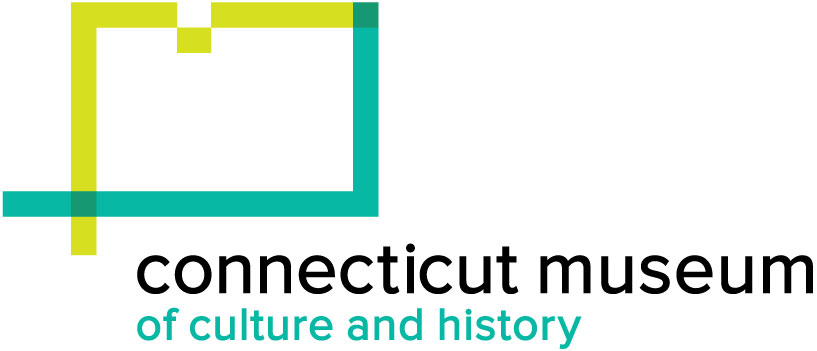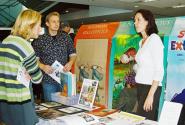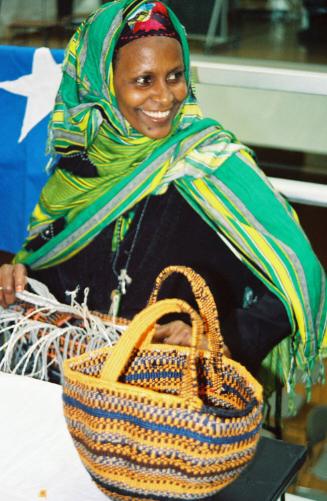World Refugee Day, 2008
SubjectPortrait of
Florence Betgeorge
(Assyrian)
SubjectPortrait of
Fatuma Ahmed
(Somali)
SubjectPortrait of
Fatima Vejzovic
(Bosnian)
SubjectPortrait of
Rolandas Kiaulevicius
(Lithuanian)
SubjectPortrait of
Asta Nenortas
Date2008 June 21
Mediumborn digital photography
ClassificationsGraphics
Credit LineConnecticut Cultural Heritage Arts Program collections
CopyrightIn Copyright
Object number2015.196.1002.9-.19
DescriptionPhotographs of artists displaying their work and interacting with visitors at World Refugee Day 2008 held at the Hartford Public Library on June 21 2008.
(.9) Image of a Burmese Karen weaving on a backstrap loom.
(.10-.11) Images of Assyrian lace maker Florence Betgeorge showing her lace to a visitor.
(.12) Image of Somali basketmaker Fatuma Ahmed showing her basket making technique to a visitor.
(.13-.14) Images of Sewing Circle artists (left to right) Florence Betgeorge, Fatima Vejzovic, and Fatuma Ahmed displaying and demonstrating their textile arts.
(.15) Image of Somali basket maker Fatuma Ahmed greeting a friend.
(.16) Image of Lithuanian artists Rolandas Kiaulevicius and Asta Nenortas displaying their graphic arts work.
(.17-.18) Images of Somali basket maker Fatuma Ahmed and her twined bags.
(.19) Image of children from the Burmese Karen community with traditional woven cloths displayed at the event.
NotesSubject Note: The Sewing Circle Project began in 2007 as an initiative to encourage production, marketing, and sustainability of traditional crafts among the many immigrant and refugee communities in the Greater Hartford area and across the state. Developed by the Connecticut Cultural Heritage Arts Program based at the Institute for Community Research (ICR) in Hartford and at the Connecticut Historical Society after 2015, the project supported the remarkable traditional arts of these newcomers. Members of the Sewing Circle met regularly at ICR and also at the Hartford Public Library to work on their art forms, learn new skills, and share coffee and conversation. This cooperative environment fostered social interaction among the artists and public audiences, respected and encouraged their cultural heritage and artistic traditions, stimulated literacy improvement, and helped to develop marketplaces for their artwork. CCHAP organized gatherings, exhibits, workshops, marketplace events, promotional materials, and educational activities for the group’s participants. While most of the artists experienced war, trauma, and dislocation, they continue to practice their cultural heritage and artistic traditions, blending these with current experiences and materials to create artwork that is both beautiful and functional. Even when immigrants and refugees embrace a move that takes them to a more stable and prosperous place, resettlement poses challenges of physical and psychological adaptation. Many new Americans have eased transition by continuing, recreating, or reinventing familiar art forms. For many members of refugee communities now living in New England, practicing their familiar arts of weaving, knitting, basket making, lace making, music, dance, and storytelling helps them to cope with the trauma of the genocide and displacement their families have suffered. (.9) Image of a Burmese Karen weaving on a backstrap loom.
(.10-.11) Images of Assyrian lace maker Florence Betgeorge showing her lace to a visitor.
(.12) Image of Somali basketmaker Fatuma Ahmed showing her basket making technique to a visitor.
(.13-.14) Images of Sewing Circle artists (left to right) Florence Betgeorge, Fatima Vejzovic, and Fatuma Ahmed displaying and demonstrating their textile arts.
(.15) Image of Somali basket maker Fatuma Ahmed greeting a friend.
(.16) Image of Lithuanian artists Rolandas Kiaulevicius and Asta Nenortas displaying their graphic arts work.
(.17-.18) Images of Somali basket maker Fatuma Ahmed and her twined bags.
(.19) Image of children from the Burmese Karen community with traditional woven cloths displayed at the event.
Engaging with public audiences has given project participants a chance to improve their English-speaking skills and broaden their social networks and support systems. The project also brought some additional income to the artists and they became friends and co-workers sharing techniques, styles, and supplies as they created their unusual and exquisite textiles. Through a collaboration with Catholic Charities Migration and Refugee Services and the Hartford Public Library in its early days, the project expanded to offer small business training to the artists, thanks to grants from the Aurora Foundation, the Avon Hello Tomorrow Fund, the Aetna Foundation, and the Knox Foundation. CCHAP worked with the Sewing Circle Project artists to promote their work through marketplace and museum sales, exhibits, demonstrations, and apprenticeships for the experienced artists to teach younger members of their cultural group.
Biographical Note: Somalia has experienced a complex and continuous civil war among rival clans since 1991, leading to violence, famine, and dislocation for hundreds of thousands of Somalis and Somali Bantus. Fatuma Ahmed, along with her farmer husband and their children, belonged to the Ashraf, a Somali minority group often targeted by larger armed clans. With thousands of others, the family fled across country on donkeys and camels to a large refugee camp in Kenya in 1992. After thirteen years in the camp, Fatuma and her eight children received asylum in the United States, arriving in 2005. Although she had not gone to school in Somalia, Fatuma was skilled at handwork with intricate twined designs, making woven sisal mats and baskets that brought some income in the camps. In her new home in Connecticut she continued her basket-making with the Sewing Circle project. Practicing her craft reminds Fatuma of Somali cultural practices, and provides a way to contribute her personal skills to American cultural life. Fatuma moved to Minneapolis in 2014 and went back to live in Somalia in 2018.
Farming families in Somalia, both Somali and Somali Bantu, make mats, baskets, and bags from woven and twined sisal strips or palm leaves. These essential domestic items carry crops and food, store household goods, and transport shopping. Called dambiil in both Somali and Somali Bantu languages, the soft-sided baskets can be plain or patterned. The mats have several uses, each with a different name; they serve as prayer rugs, floor or wall coverings, serving platters, and winnowing trays. In Connecticut Fatuma uses plastic baling twine as the warp to shape the circular basket, then she twists colored yarn around the twine to build up the sides and adds yarn handles. She experiments with colors and basket styles to meet the preferences of the American market. Fatuma sells her work at the Hartford Farmers Market and other venues, and is teaching her daughters the craft.
Biographical Note: Florence Betgeorge (Betgevargiz also) was born in northern Iran in the Azerbaijan Province, a traditionally Assyrian Christian area. Assyrians speak a language similar to ancient Aramaic, and trace descent from the Babylonians of Mesopotamia. Florence attended Catholic school in Iran, also learning textile arts from the French nuns who ran the school. After her marriage and a move to Tehran, diplomats and other wealthy patrons commissioned baby clothes, bedcovers, and trousseaux from her. Persecution of Assyrians intensified in Iran after the fall of the Shah and during the Islamic Revolution from 1978-1982, and Florence and her family immigrated to the US in 1984. They settled in New Britain, CT where Assyrians have established a strong community with a church and a cultural center. Florence creates exquisite embroidery, lace, decorative home textiles, and she can tailor any garment. Sharokin Betgevargiz, Florence’s daughter, learned lace-making with her mother as part of the Southern New England Traditional Arts Apprenticeship Program in 2007-2008 and continues to create lace earrings, necklaces, and table covers, sometimes using unusual threads made of metal. Florence has participated in many activities of CCHAP’s Sewing Circle Project from 2007. CCHAP has displayed her work in several exhibitions. One of her knotted lace pieces is in the collection of the Connecticut Museum of Culture and History, 2015.217.0, and she donated a hand-picked handkerchief to the collection, 2015.232.0..
Florence makes lace using only a needle and 2 or 3 ply fine cotton thread, in a French style she learned from nuns. This style creates knots that secure the delicate thread as the lace strands are built up, whereas in crochet lace the stitches are continuous and unravel if pulled. She describes her lace technique as “needlework” or dentelle in French. Her special addition to this technique creates writing in lace, with scripts in Aramaic.
Biographical Note: The Karen are a group of tribal people living in the hills of northern Burma and northern Thailand. Forced out of Burma by repressive military governments since 1975, Karen refugees relocated to camps in Thailand. Over 200 Karen have settled in Hartford in recent years, bringing with them excellent musical and textile skills. Many Karen can weave their own cloth, making traditional shirts, sarongs, and shoulder bags. Although the preferred materials for looms and cloth can be difficult to find, family members build looms for the weavers using PVC pipes instead of bamboo. Hartford is now home to several Karen weavers - Mu Wah learned all the techniques of weaving from her mother starting at the age of ten. She and weaver Hser Nay Paw came to Hartford in 2007, joining the sewing circle as a way to continue their cultural heritage. Myint Khin arrived in Connecticut in early September 2013, to reunite with her family. She learned to weave from teachers in the Thailand camp, and has now taught her four daughters.
Karen women and men weave their fine cotton cloth on backstrap looms that can be rolled up and transported from place to place. First the threads are stretched out in a continuous loop around an upright frame with wooden or bamboo posts that hold the yarn tight. Then this set of threads still on the posts is lifted off the frame and turned horizontally to form the warp that is now stretched out as the basis of the cloth. The weaver ties one of the posts to a stationary object such as a tree, with the other post in front of her and tied at either end to a strap around her back. Leaning back to create tension on the warp threads, she can weave back and forth between the threads to create cloth. Intricate patterns with dyed threads are woven into the base cloth, and weavers will sometimes embellish the cloth with embroidery and beads made of seeds. Specific patterns can tell stories or reflect inspirations and knowledge from nature, in a kind of visual narrative. Different colors and stripe patterns can denote marital status or occupations of the person wearing the cloth.
Hartford is now home to several Karen weavers – Hser Nay Paw, Mu Wah, Nu Wah, Pwe Say Paw, and Myint Khin are some of the Burmese Karen weavers who use traditional backstrap looms to make the clothing worn by all members of their large community in Hartford. Their woven cloth, bags, shirts, and scarves have been exhibited by CCHAP in several exhibits including Weaving a New Life: The Refugee Artists Sewing Circle at the Clare Gallery in Hartford in 2009, and in the 2013-2015 traveling exhibit New Lives New England, displayed at the Vermont Folklife Center in Middlebury VT, and the Institute for Community Research in Hartford. Myint Khin and Mu Wah traveled with CCHAP to demonstrate weaving at the Vermont Folklife Center in December 2013.
Mu Wah learned all the techniques of weaving from her mother starting at the age of ten. She and weaver Hser Nay Paw came to Hartford in 2007, joining the Sewing Circle Project as a way to continue their cultural traditions. Myint Khin is a Burmese Karen master weaver who arrived in early September 2013 to live with family members already settled in Hartford. She learned to weave from teachers in the Thailand refugee camp, and has now taught her daughters. She has presented programs in Greater Hartford schools, with students from Miss Porters School, and at Trinity College to show students her back strap weaving and the clothes she makes. Myint was a popular weaver in the refugee camp in Thailand where her four daughters were born, three of them are also weavers. Myint is in demand as a weaver and seamstress for the Burmese Karen community in Connecticut and New England.
Biographical Note: Fatima Vejzovic is a skilled weaver of traditional Bosnian wool flat-weave carpets made on a simple wooden loom constructed by family members in her home. She learned this traditional craft from mothers, aunts, neighbors, and friends in her village, using wool from sheep raised on their farm. After the war Fatima and many weavers worked for Bosfam, a successful crafts cooperative established in Tuzla to assist women with income-generating projects while providing therapeutic and social support. Their work has appeared in catalogues selling the carpets internationally. Fatima arrived in Hartford with her family in 2002. Greater Hartford is now home to several thousand Bosnians, most coming as refugees from the war in the former Yugoslavia. For the women in the community, many of them widows, continuing to practice their familiar arts of weaving, knitting, and crochet lace helps them to cope with the trauma of the genocide their families suffered. Fatima’s art works include large floor carpets as well as smaller weavings, and she fashions the woven tapestry fabric into bags, purses, and pillows. Fatima also makes hand-knitted clothes, crochet lace tablecloths, and Bosnian socks worn inside the home. She won a 2021 Connecticut Office of the Arts Fellowship in Folk and Traditional Arts.
Bosnian flat-weave carpets, called ćilimi after their Turkish antecedents (kilims), adorn all parts of the home – floors, walls, chairs and sofas, tables, beds. The weavings also serve an important function as prayer rugs for these Muslim families. While sometimes made commercially with chemical dyes, the traditional rugs woven by village women still use wool processed by them and colored with natural dyes. Ćilimi designs maintain their Turkish roots but also show European influences stemming from Bosnia’s close connections with Vienna in the early 20th century. Fatima weaves traditional geometric patterns in seemingly endless variations, and she also enjoys adding floral motifs and creating new pictorial designs. Fatima does not use templates or printed patterns – her designs are created as she starts a weaving on the loom, depending on what colors of wool she has available. She developed a new idea for a weaving depicting a whimsical goat, that she made into bags and wall hangings that have become very popular. Fatima also weaves lettering and names into a ćilim, creating a narrative feature that led to a multi-year commission to produce commemorative banners in the organization’s colors for the Aurora Foundation’s retiring board members.
Through a partnership with Clatter Ridge Farm, whose sheep graze on the grounds of the Hill-Stead Museum in Farmington, Connecticut, Fatima has created a series of weavings using their high-quality Shetland wool. The undyed wool gives the rugs a beautiful softness and durability as well as subtle variations of natural color. These special weavings are in the collection of the Hill-Stead Museum, the Connecticut Historical Society, and several private collections.
Fatima taught her daughter Fikreta Muratovic to weave and they worked together for the Bosfam enterprise in Bosnia. As part of the Southern New England Traditional Arts Apprenticeship Program in 2005, Fatima taught loom weaving to a younger Bosnian woman in Hartford, helping to pass on this beloved tradition in their new home. Fatima has given weaving workshops to Hartford students at four schools through Hartford Performs, and to students from Miss Porters School and the Greater Hartford Academy of the Arts. Fatima has worked with three interns from Trinity College through the Sewing Circle Project. As part of the Hartford Performs program for teaching artists in schools, Fatima has taught the basics of loom weaving to students in Hartford, Windsor Locks, and Miss Porter’s School.
Fatima was one of the founding members of the Sewing Circle Project which began in early 2007 as a partnership to encourage cultural sustainability among the many immigrant and refugee communities in the Greater Hartford area and across Connecticut. Engaging with public audiences has given Fatima opportunities to improve her English-speaking skills, broaden her social networks, and showcase Bosnian cultural traditions. She has demonstrated and sold her work at the Hartford Public Library World Refugee Day; Hartford Open Studio Weekends; the University of Connecticut; the Hill-Stead Museum; the Vermont Folklife Center; the American Folklore Society; the New York Folklore Society; the West Hartford Art League; Ten Thousand Villages; several local house parties; and at the Billings Forge Farmers Market. She enjoys creating new designs for private commissions. Fatima’s work has been included in exhibitions at the Institute for Community Research, the Connecticut Historical Society, the Connecticut Office of the Arts Gallery, and the Clare Gallery.
Biographical Note: Graphic artist Asta Nenortas plays a central role in Connecticut’s Lithuanian community, for many years helping to organize the annual Lithuanian Scouts Food and Crafts Fair held at Holy Trinity Church at 53 Capitol Avenue in Hartford, the spiritual heart of the community. Asta has been a dancer in and the leader of the Lithuanian folk dance group Berzelis that performs nationally. She also makes Easter wands of straw and flowers. Called Palms of Vilnius, these decorations symbolize the first growth of plants in the spring, represent health and healing, and also simulate the consecrated palms of Easter.
Biographical Note: Lithuanian graphic artist and illustrator Rolandas Kiaulevicius (Dabrukas), a professor of art at Eastern Connecticut State University, has illustrated children’s books and coloring books, and produces greeting cards, murals, and fashion designs as a multi-faceted artist.
Additional audio, video, and/or photographic materials exist in the archive relating to these artists.
Cataloging Note: This project was made possible in part by the Institute of Museum and Library Services MA-245929-OMS-20.
Status
Not on viewFatima Vejzovic
2009 January-February
























